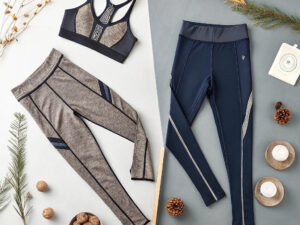Yoga pants and leggings—both are stretchy, snug, and found in every modern wardrobe. But are they the same thing with different names, or do they actually serve different purposes?
The main difference between yoga pants and leggings lies in their design, fabric, and intended use. Yoga pants are specifically engineered for exercise, with performance features like moisture-wicking and thicker materials, while leggings are often designed for casual wear or layering.
Let’s dive into the key distinctions between yoga pants and leggings, so you can make the right choice for your workout, your weekend, or your wardrobe.
What are yoga pants?
Yoga pants are made for movement.
Yoga pants are athletic bottoms designed to stretch, support, and stay in place during physical activity—particularly yoga. They’re usually made from performance fabrics and offer features that enhance flexibility and moisture control.
Characteristics of Yoga Pants:
✔ Made from moisture-wicking1, durable fabrics
✔ Include spandex for high elasticity
✔ Offer a snug, supportive fit
✔ Often high-waisted for core support
✔ Can come in various cuts: full-length, cropped, bootcut, or flared
✔ Built for high mobility2 and comfort
Yoga pants are a functional piece of activewear—meant to perform, not just look good.
What are leggings?
Leggings are casual, everyday essentials.
Leggings are tight-fitting pants made from stretchy materials, usually designed for comfort and layering rather than high-intensity movement. While some leggings cross over into activewear, many are made for lifestyle wear.
Characteristics of Leggings:
✔ Softer, more casual fabrics like cotton or modal
✔ Often thinner and less structured
✔ Usually not sweat-resistant or compressive
✔ Ideal for layering under dresses or lounging
✔ May become see-through when stretched
✔ Typically worn outside the gym setting
Leggings are more about comfort and style than performance.

What’s the difference in fabric between yoga pants and leggings?
The fabric tells you a lot.
Yoga pants use performance materials3 like polyester-spandex or nylon-spandex blends that wick moisture, retain shape, and offer better coverage. Leggings are often made from cotton blends or modal with less spandex and more softness.
Fabric Comparison:
| Feature | Yoga Pants | Leggings |
|---|---|---|
| Material | Nylon/poly + spandex | Cotton/modal + spandex |
| Stretch | 4-way stretch | 2- to 4-way stretch |
| Sweat-wicking | Yes | Often no |
| Thickness | Mid to high | Low to mid |
| Sheerness | Squat-proof | May show through |
The higher performance of yoga pant fabrics makes them ideal for active use.
What about fit and design differences?
Yoga pants are engineered for movement, while leggings prioritize softness and ease.
Yoga Pants Fit:
✔ Snug and supportive
✔ High waistband for security
✔ Flatter seams and gussets for flexibility
✔ Designed to stay in place during dynamic poses
Leggings Fit:
✔ Stretchy but looser in support
✔ Lower or mid-rise waistbands
✔ May roll down during movement
✔ Designed more for comfort than activity
While they may look similar on a hanger, yoga pants will feel more stable and secure in motion.
Are all yoga pants leggings?
Not exactly—but there is overlap.
All yoga leggings are technically leggings, but not all leggings are yoga pants. Yoga pants may include leggings, joggers, flares, or bootcut designs. The key is in the purpose, not just the silhouette.

Common Types of Yoga Pants:
- Yoga leggings – Tight, stretchy, high-rise
- Yoga joggers – Looser, tapered legs with a cuff
- Bootcut yoga pants – Slightly flared at the ankle
- Cropped or capri yoga pants – Mid-calf length for warmer weather
Meanwhile, everyday leggings stick with the classic form-fitting style and may lack technical performance features.
When should you wear yoga pants vs. leggings?
Choose based on the activity—and the level of movement involved.
Wear Yoga Pants When:
✔ Doing yoga or Pilates
✔ Working out or stretching
✔ Running errands post-gym
✔ Needing support, coverage, and structure
Wear Leggings When:
✔ Lounging at home
✔ Layering under tunics or dresses
✔ Traveling in comfort
✔ Casual settings with low movement
Let the purpose guide your fabric and fit choice.
Are yoga pants better than leggings?
That depends on how you use them.
If you’re exercising, yoga pants offer better performance. If you’re relaxing or styling an outfit, leggings might be the softer, more comfortable option.
Pros of Yoga Pants:
✔ Durable and sweat-ready
✔ Better shape retention
✔ Designed for high movement
✔ More versatile for workouts and errands
Pros of Leggings:
✔ Soft, cozy, and breathable
✔ Affordable and widely available
✔ Perfect for layering or lounging
✔ Often more fashion-focused
The best wardrobe includes both—each serves a different need.
How to tell the difference when shopping
Look at the tags, feel the fabric, and test the stretch.
What to Check:
✔ Label mentions moisture-wicking or sweat resistance? → Yoga pants
✔ Fabric feels thicker and bounce-back stretchy? → Yoga pants
✔ Tag mentions casual or layering? → Leggings
✔ Price and brand placement? → Activewear brands tend to label clearly
Some brands even label their products as “yoga leggings” or “performance tights” to signal intended use.
Conclusion
The main difference between yoga pants and leggings comes down to function and fabric. Yoga pants are made for movement—with performance materials, compression, and support. Leggings lean into comfort—great for lounging, layering, or low-intensity activity. The best choice depends on your lifestyle, your activity level, and how you want to feel throughout the day.
-
Explore how moisture-wicking fabrics enhance comfort and performance in activewear, making them essential for workouts. ↩
-
Discover why high mobility is crucial for activewear, especially for yoga and other physical activities, to enhance your performance. ↩
-
Learn about performance materials and their advantages in activewear, ensuring you choose the best gear for your activities. ↩














